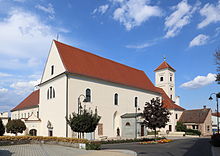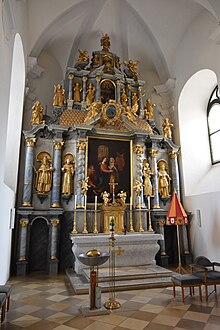Franciscan monastery and monastery church Güssing
Franciscan monastery and monastery church of the Visitation of the Franciscans (OFM) with the Batthyan family crypt in the city of Güssing in Burgenland is a listed building . In 2013 the monastery church was elevated to a minor basilica .
history
An Augustinian hermit monastery was abandoned in the same place in 1574. The abandoned monastery was destroyed in the 1st half of the 17th century. In 1648 a new monastery was founded and probably built according to plans by the imperial court architect Philiberto Lucchese and moved into in 1649.
Franciscan monastery
The monastery is a three-wing building and forms a square with the church. The surrounding cloister in the inner courtyard leans against the left nave wall of the church in the south. In the cloister is a Roman tombstone with an inscription. In the monastery is an altar from 1662, transferred here from the parish church of Güssing . The monastery library includes manuscripts, incunabula and first prints.
Monastery church
- External church building
The large church has a simple gable front with an entrance portal in the west. There is a Batthyány coat of arms above the west portal . In the east, the low, recessed choir adjoins with a 3/8 end, to this, in the same axis, the three-storey east tower. In 1977, three Gothic windows were uncovered in the south wall of the church. There are two gravestones on the outer wall: the red marble stone from the 16th century shows a knight with a flag (Franz Batthyány?), The white marble stone shows the inscription of Balthasar Batthyány (1543–1590).
- Church interior
The four-bay nave has a groin vault between flat belts on high pilasters. The gallery is vaulted with a groin vault. Behind the round arched triumphal arch, the choir bay begins with a groin vault and oratorio windows. The end of the choir has vaulted caps and broken straps.
- Furnishing
According to the certificate, the high altar was created by the sculptor Matthäus Kern and the painter Wolfgang Resch from Graz, perhaps based on a design by Philiberto Lucchese , and was completed in 1649. The altar as an imitation of a three-story building shows the image of the Visitation of the Virgin Mary between winding columns on the first floor and bears the figures of St. Kings Stephan and Ladislaus, two Franciscans and the Batthyány coat of arms. Above a shed roof on the second floor, the altar shows the image of the Assumption and bears eight figures of saints. On a small shed roof over a vented gable in the top, the altar shows the image of Trinitas and the figures of the Madonna and Angel.
The two-storey side altars on the triumphal arch pillars were built by the sculptor and carpenter Hans Fellner from Hartberg between 1652 and 1654. They show the image of St. Franz Xavier and on the right the image of St. Anthony of Padua and carry small figures of saints. The left side altar in the nave from 1745, a flat wall altar with entablature, shows the image of the Mariazell Mother of God with an old view of Maria Trost . The right side altar from 1725 with a mighty structure with double columns and heavy entablature and top shows the image of St. Johannes Nepomuk .
The pulpit is from the first half of the 18th century, the font from the 18th century. The fourteen stations of the cross (oil paintings) are from the second half of the 18th century. In the sacristy there is a parament box from 1725 with carving and painting in the old version.
Loretto Chapel
The portal to the Loretto Chapel attached to the choir on the right is from the 17th century. The altar with twisted columns bears a black Madonna in a bell cloak from the 18th century.
Batthyany family crypt
The private crypt of the Batthyánys is after the "Kaisergruft" in Vienna, the second largest private crypt in Austria. The family crypt is a portal building on the south front of the church with an inscription with two chronograms from 1648 and was structurally expanded in 1830 and 1970. Above the pylon-like portal frame is a plastic group with two coats of arms. In the crypt, which is located in spacious rooms under the church, there are around 100 simple coffins (1976). The lead sarcophagus by the sculptor Balthasar Ferdinand Moll for Karl Josef Batthyány (1697–1772) is remarkable . The doctor Ladislaus Batthyány-Strattmann (1870–1931) was beatified in 2003. Most recently, Ladislaus Pascal Prince Batthyány-Strattmann of Német-Ujvar (born March 26, 1938 in Budapest, † February 14, 2015 in Vienna) was buried in the family crypt.
literature
- The art monuments of Austria. Dehio Burgenland 1976 , Güssing, Franciscan monastery, Mariae Visitation monastery church, Loretto Chapel, Batthyan family crypt, pp. 120–121.
Web links
Coordinates: 47 ° 3 ′ 34.7 ″ N , 16 ° 19 ′ 25.6 ″ E




